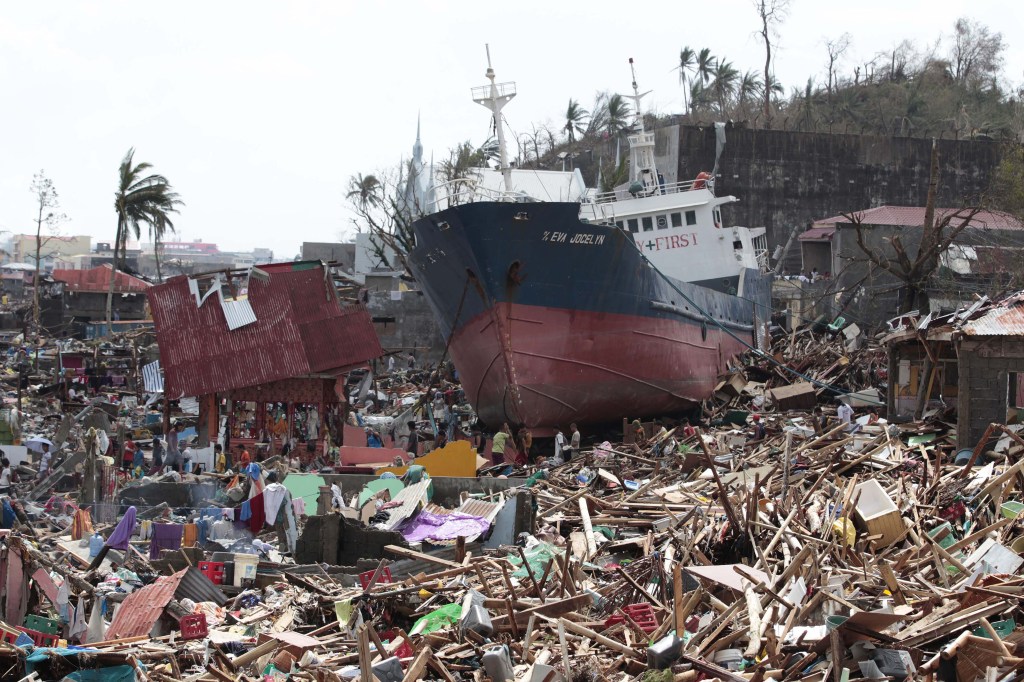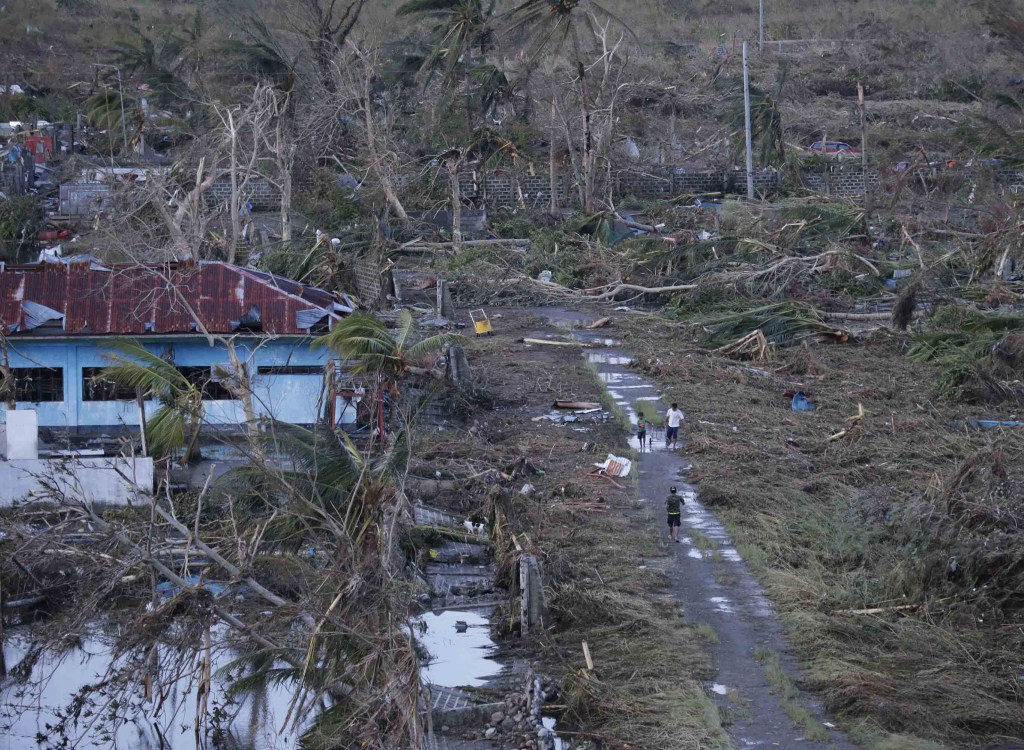TACLOBAN, Philippines – Corpses hung from trees, were scattered on sidewalks or buried in flattened buildings – some of the thousands believed killed in one Philippine city alone by ferocious Typhoon Haiyan that washed away homes and buildings with powerful winds and giant waves.
As the scale of devastation became clear Sunday from one of the worst storms ever recorded, officials said emergency crews could find more bodies when they reach parts of the archipelago cut off by flooding and landslides. Desperate residents raided grocery stores and gas stations in search of food, fuel and water as the government began relief efforts and international aid operations got underway.
Even in a nation regularly beset by earthquakes, volcanoes and tropical storms, Typhoon Haiyan appears to be the deadliest natural disaster on record.
Haiyan hit the eastern seaboard of the Philippines on Friday and quickly barreled across its central islands, packing winds of 235 kph (147 mph) that gusted to 275 kph (170 mph), and a storm surge of 6 meters (20 feet).
Its sustained winds weakened to 133 kph (83 mph) as it crossed the South China Sea before approaching northern Vietnam, where it was forecast to hit land early Monday. Authorities there evacuated hundreds of thousands of people.
Hardest hit in the Philippines was Leyte Island, where regional Police Chief Elmer Soria said the provincial governor had told him there were about 10,000 dead, primarily from drowning and collapsed buildings. Most were in Tacloban, the provincial capital of about 200,000 people that is the biggest city on the island.
Reports also trickled in indicating deaths elsewhere on the island.
On Samar Island, Leo Dacaynos of the provincial disaster office said 300 people were confirmed dead in one town and another 2,000 were missing, with some towns yet to be reached by rescuers. He pleaded for food and water, adding that power was out and there was no cellphone signal, making communication possible only by radio.
Reports from other affected islands indicated dozens, perhaps hundreds more deaths.
With communications still knocked out in many areas, it was unclear how authorities were arriving at their estimates of the number of people killed, and it will be days before the full extent of the storm is known.
“On the way to the airport, we saw many bodies along the street,” said Philippine-born Australian Mila Ward, 53, who was waiting at the Tacloban airport to catch a military flight back to Manila, about 580 kilometers (360 miles) to the northwest. “They were covered with just anything – tarpaulin, roofing sheets, cardboard.” She said she passed “well over 100” bodies.
In one part of Tacloban, a ship had been pushed ashore and sat amid damaged homes.
Haiyan inflicted serious damage to at least six of the archipelago’s more than 7,000 islands, with Leyte, Samar and the northern part of Cebu appearing to bear the brunt of the storm. About 4 million people were affected by the storm, the national disaster agency said.
Video from Eastern Samar province’s Guiuan township – the first area where the typhoon made landfall – showed a trail of devastation. Many houses were flattened and roads were strewn with debris and uprooted trees. The ABS-CBN video showed several bodies on the street, covered with blankets.
“Even me, I have no house, I have no clothes. I don’t know how I will restart my life, I am so confused,” an unidentified woman said, crying. “I don’t know what happened to us. We are appealing for help. Whoever has a good heart, I appeal to you – please help Guiuan.”
The Philippine National Red Cross said its efforts were hampered by looters, including some who attacked trucks of food and other relief supplies it was shipping to Tacloban from the southern port of Davao.
Tacloban’s two largest malls and grocery stores were looted, and police guarded a fuel depot. About 200 police officers were sent into Tacloban to restore law and order.
With other rampant looting reported, President Benigno Aquino III said he was considering declaring a state of emergency or martial law in Tacloban. A state of emergency usually includes curfews, price and food supply controls, military or police checkpoints and increased security patrols.
The massive casualties occurred even though the government had evacuated nearly 800,000 people ahead of the typhoon.
Aquino flew around Leyte by helicopter on Sunday and landed in Tacloban. He said the government’s priority was to restore power and communications in isolated areas and deliver relief and medical assistance.
Challenged to respond to a disaster of such magnitude, the Philippine government also accepted help from abroad.
President Barack Obama said in a statement that he and his wife, Michelle, were “deeply saddened” by the deaths and damage from the typhoon. He said the U.S. was providing “significant humanitarian assistance” and was ready to assist in relief and recovery efforts.
U.S. Defense Secretary Chuck Hagel directed the Pacific Command to deploy ships and aircraft to support search-and-rescue operations and fly in emergency supplies.
U.N. Secretary-General Ban Ki-moon was “extremely concerned” by the widespread destruction and the steeply rising death toll, according to a statement released by his office.
Ban said the U.N. and its humanitarian partners “have quickly ramped up critical relief operations” even though many communities remain difficult to reach, the statement added.
Pope Francis led tens of thousands of people at the Vatican in prayer for the victims. The Philippines has the largest number of Catholics in Asia, and Filipinos are one of Rome’s biggest immigrant communities.
The Philippines is annually buffeted by tropical storms and typhoons, which are called hurricanes and cyclones elsewhere. The nation is in the northwestern Pacific, right in the path of the world’s No. 1 typhoon generator, according to meteorologists. The archipelago’s exposed eastern seaboard often bears the brunt.
Even by the standards of the Philippines, however, Haiyan is a catastrophe of epic proportions and has shocked the impoverished and densely populated nation of 96 million people. Its winds were among the strongest ever recorded, and it appears to have killed more people than the previous deadliest Philippine storm, Thelma, in which about 5,100 people died in the central Philippines in 1991.
The country’s deadliest disaster on record was the 1976 magnitude-7.9 earthquake that triggered a tsunami in the Moro Gulf in the southern Philippines, killing 5,791 people.
Defense Secretary Voltaire Gazmin said Aquino was “speechless” when he told him of the devastation in Tacloban.
“I told him all systems are down,” Gazmin said. “There is no power, no water, nothing. People are desperate. They’re looting.”
Tacloban, in the east-central Philippines, is near the Red Beach on Leyte Island where U.S. Gen. Douglas MacArthur waded ashore in 1944 during World War II and fulfilled his famous pledge: “I shall return.”
It was the first city liberated from the Japanese by U.S. and Filipino forces and served as the Philippines’ temporary capital for several months. It is also the hometown of former Filipino first lady Imelda Marcos, whose nephew, Alfred Romualdez, is the city’s mayor.
One Tacloban resident said he and others took refuge inside a Jeep, but the vehicle was picked up by a surging wall of water.
“The water was as high as a coconut tree,” said 44-year-old Sandy Torotoro, a bicycle taxi driver who lives near the airport with his wife and 8-year-old daughter. “I got out of the Jeep and I was swept away by the rampaging water with logs, trees and our house, which was ripped off from its mooring.
“When we were being swept by the water, many people were floating and raising their hands and yelling for help. But what can we do? We also needed to be helped,” Torotoro said.
In Torotoro’s village, bodies were strewn along the muddy main road as now-homeless residents huddled with the few possessions they managed to save. The road was lined with toppled trees.
UNICEF estimated that 1.7 million children live in areas affected by the typhoon, according to the agency’s representative in the Philippines, Tomoo Hozumi. UNICEF’s supply division in Copenhagen was loading 60 metric tons of relief supplies for an emergency airlift expected to arrive in the Philippines on Tuesday.
“The devastation is … I don’t have the words for it,” Interior Secretary Mar Roxas said. “It’s really horrific. It’s a great human tragedy.”
In Vietnam, about 600,000 people living in the central region who had been evacuated returned to their homes Sunday after a weakened Haiyan changed directions and took aim at the country’s north.
Four people in three central Vietnamese provinces died while trying to reinforce their homes for the storm, the national floods and storms control department said Sunday.
Associated Press writers Oliver Teves and Teresa Cerojano in Manila, Minh Tran in Hanoi, Vietnam, and Kirsten Grieshaber in Berlin contributed to this report.
Copy the Story LinkSend questions/comments to the editors.




Success. Please wait for the page to reload. If the page does not reload within 5 seconds, please refresh the page.
Enter your email and password to access comments.
Hi, to comment on stories you must . This profile is in addition to your subscription and website login.
Already have a commenting profile? .
Invalid username/password.
Please check your email to confirm and complete your registration.
Only subscribers are eligible to post comments. Please subscribe or login first for digital access. Here’s why.
Use the form below to reset your password. When you've submitted your account email, we will send an email with a reset code.